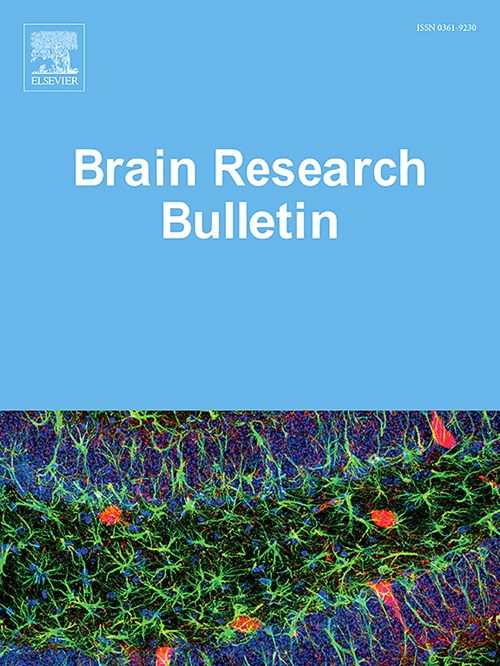Fiber connectivity density in subcortical stroke patients with behavioral dysexecutive symptoms
IF 3.5
3区 医学
Q2 NEUROSCIENCES
引用次数: 0
Abstract
Subcortical stroke induces widespread connectivity changes between cortical and subcortical regions, which may underpin the ensuing behavioral dysexecutive symptoms. This study therefore investigated the cortical structural connectivity that were related to behavioral dysexecutive symptoms using fiber connectivity density (FiCD) mapping, an approach which combines white matter (WM) fiber tractography and cortex reconstruction. The relationships between cortical structural connectivity of significant clusters and its corresponding cortical thickness (CT), and clinical variables were also evaluated based on region-of-interest analysis. Sixty-four subcortical stroke patients with high-resolution T1-weighted imaging and diffusion tensor imaging were enrolled and the behavioral dysexecutive symptoms were assessed using the dysexecutive questionnaire. The FiCD of the left superior parietal gyrus was positively associated with cognitive executive processing (CTT1 time, r = 0.570, p = 0.047; CVFT total correct, r = 0.582, p = 0.047; CVFT total response, r = 0.605, p = 0.040). Similary, the FiCD of the right superior parietal gyrus was also positively associated with cognitive executive processing, (CTT1 time, r = 0.639, p = 0.034). Conversely, negative correlations were observed between the FiCD and CT of the right (r = -0.612 p = 0.045) superior parietal gyrus.
具有行为执行障碍症状的皮质下脑卒中患者的纤维连接密度
皮层下中风引起皮层和皮层下区域之间广泛的连通性改变,这可能是随后的行为执行障碍症状的基础。因此,本研究利用纤维连接密度(FiCD)作图研究了与行为执行障碍症状相关的皮层结构连通性,这种方法结合了白质(WM)纤维束图和皮层重建。基于感兴趣区域分析,评估显著簇的皮质结构连通性与其相应的皮质厚度(CT)和临床变量之间的关系。采用高分辨率t1加权成像和弥散张量成像方法对64例皮质下脑卒中患者的行为执行障碍症状进行评估。左顶叶上回FiCD与认知执行加工呈正相关(CTT1时间,r = 0.570,p = 0.047;CVFT合计正确,r = 0.582,p = 0.047;CVFT总响应,r = 0.605,p = 0.040)。同样,右侧顶叶上回的FiCD也与认知执行加工呈正相关(CTT1时间,r = 0.639,p = 0.034)。相反,右侧顶叶上回的FiCD与CT呈负相关(r = -0.612 p = 0.045)。
本文章由计算机程序翻译,如有差异,请以英文原文为准。
求助全文
约1分钟内获得全文
求助全文
来源期刊

Brain Research Bulletin
医学-神经科学
CiteScore
6.90
自引率
2.60%
发文量
253
审稿时长
67 days
期刊介绍:
The Brain Research Bulletin (BRB) aims to publish novel work that advances our knowledge of molecular and cellular mechanisms that underlie neural network properties associated with behavior, cognition and other brain functions during neurodevelopment and in the adult. Although clinical research is out of the Journal''s scope, the BRB also aims to publish translation research that provides insight into biological mechanisms and processes associated with neurodegeneration mechanisms, neurological diseases and neuropsychiatric disorders. The Journal is especially interested in research using novel methodologies, such as optogenetics, multielectrode array recordings and life imaging in wild-type and genetically-modified animal models, with the goal to advance our understanding of how neurons, glia and networks function in vivo.
 求助内容:
求助内容: 应助结果提醒方式:
应助结果提醒方式:


